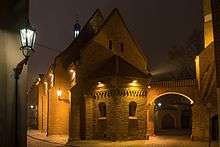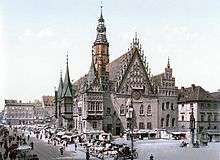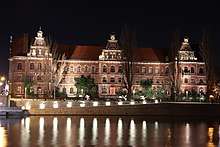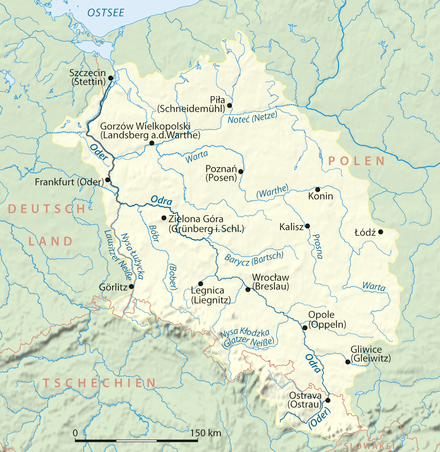Timeline of Wrocław
The following is a timeline of the history of the city of Wrocław, Poland.
Historical affiliations
Silesians until the 800s

![]()
![]()
![]()
![]()

![]()
![]()
![]()
![]()
![]()
![]()
![]()
![]()
![]()
Prior to 16th century
- around 550 - At the end of the Migration Period around and in the present areas of Wrocław, the Slavic tribe of Ślężanie settled.
- 985 - Mieszko I of Poland in power.
- 1000
- Bishopric of Wrocław established.[1]
- Population: 1,000 (approximate).
- 1037 - Uprising.
- 1038 - Bohemians in power.
- 1054 - Poles in power.
- 1109 - August 24: Battle of Hundsfeld (Psie Pole), Polish victory against the invading Germans.
- ca. 1112/1118 - Wrocław named one of the three major cities of the Polish Kingdom alongside Kraków and Sandomierz in the Gesta principum Polonorum.
- 1138 - Town becomes capital of Duchy of Silesia within the fragmented Polish realm.

Romanesque church of St. Giles, the oldest preserved church of Wrocław
- around 1240 - Church of St. Vincent founded by High Duke of Poland Henry II the Pious.
- 1241
- Town besieged by Mongols during the First Mongol invasion of Poland.[2]
- Burial of Henry II the Pious, killed in the Battle of Legnica, in the Church of St. Vincent,[3] as the first Polish monarch to be buried in Wrocław.
- 1242 - Church of St. Giles built.
- 1257 - Church of St. Elizabeth built.[4]
- 1262 - Magdeburg rights adopted.
- 1272 - Cathedral of St. John the Baptist consecrated.
- 1273 - Piwnica Świdnicka, one of the oldest still operating restaurants in Europe, opened.[5]
- 1274 - Duke Henryk IV Probus granted Wrocław staple right.
- 1288 - Holy Cross church founded by High Duke of Poland Henryk IV Probus.[6]
- 1290 - Death and burial of Henryk IV Probus in the Holy Cross church, that was still under construction,[6] as the second Polish monarch to be buried in Wrocław.
- 1295 - Holy Cross church consecrated.[4]
- 1333 - Town Hall building expanded.
- 1335 - City annexed to Bohemia.[4]
- 1342 - Fire.
- 1344 - Fire.
- 1348 - Charles IV, Holy Roman Emperor visits the city.
- 1351 - Saints Stanislaus, Dorothy and Wenceslaus church founded.[2]
- 1362 - St. Mary Magdalene Church built.
- 1387 - City joins Hanseatic League.
- 1418 - Guild revolt.
- 1466 - Meeting of Polish diplomat Jan Długosz and the papal legate in Wrocław, which enabled peace talks between Poland and the Teutonic Order, which culminated a few months later in the signing of a peace treaty in Toruń ending the Thirteen Years' War.[7]
- 1469 - City passed to Hungarian King Matthias Corvinus.
- 1474
The oldest printed text in the Polish language in the Statuta Synodalia Episcoporum Wratislaviensis, printed in Wrocław by Kasper Elyan, 1475
- 1475 - Kasper Elyan founded the Drukarnia Świętokrzyska (Holy Cross Printing House), the city's first printing house, which in the same year published the Statuta synodalia episcoporum Wratislaviensium, the first ever incunable in Polish.[9]
- 1490 - City passed to Bohemia.
- 1492 - Pillory erected at the Market Square.[4]
16th–18th centuries
- 1523 - Protestant Reformation.[2]
- 1527 - City annexed to Austria.[4]
- 1530 - City coat of arms adopted.
- 1585 - Plague.
- 1666 - Polish Municipal School (Miejska Szkoła Polska) opened.
- 1670 - Miscellanea Curiosa Medico-Physica, the world's first medical journal published.
- 1672 - House of the Seven Electors built.[4]
- 1702 - Leopoldina Jesuit college founded.[10]
- 1717 - Palace built.
- 1723 - Bergstadtverlag Wilhelm Gottlieb Korn (publisher) in business.
- 1741 - Prussians in power.[10]
- 1742 - Schlesische Zeitung begins publication.[11]
- 1757 - Austrians in power, succeeded by Prussians.[10]
- 1760 - City besieged.[4]
19th century
- 1806 - December: City besieged by forces of the Confederation of the Rhine.[4]
- 1807 - Old fortifications dismantled.[2]
- 1811 - Schlesische Friedrich-Wilhelm-Universität established.[2]
- 1813 - Mobilization against Napoleon of France.[4]
- 1815 - Royal Museum of Art and Antiquity established.
- 1823 - Population: 76,813.[12]
- 1824 - Exchange built.[13]
- 1829 - White Stork Synagogue opens.
- 1833 - Horse racing in Szczytnicki Park begins.
- 1836 - Slavonic Literary Society founded.
- 1841 - Opera House opens.
- 1842 - Upper Silesian Train Station built.
- 1846 - Royal Palace building renovated.[4]
- 1854 - Jewish Theological Seminary founded.
- 1856 - Jewish Cemetery established in Gabitz.
- 1857 - Central Station opens.
- 1861 - Orchestral Society founded.
- 1863 - New City Hall built.[4]
- 1865
- Zoological Garden opens.
- Theatre built.[4]
- 1871
- City becomes part of German Empire.
- New Church of St. Michael consecrated.[4]
- Opera house rebuilt.
- 1872
- New Synagogue consecrated.
- Piast Brewery in business.
- 1873 - Population: 208,025.[4]
- 1880 - Silesian Museum of Fine Arts established.
- 1883
- St. Mauritius Bridge constructed.
- Lutheran Theological Seminar opens.
- 1884 - Polish newspaper Nowiny Szląskie begins publication.
- 1886 - Viadrina (Jewish student society) formed.
- 1887 - "Government offices" built.[2]
- 1889 - Tumski Bridge constructed.
- 1890 - Population: 335,186.[2]
- 1892 - Monopol Hotel built.

Market Square with the Old Town Hall around 1900
- 1894
- Merchants Club built.[14]
- "Sokół" Polish Gymnastic Society established, as the first branch of the organization in Silesia.[15]
- 1896 - Kleinburg (Dworek) and Pöpelwitz (Popowice) villages become part of city.
- 1897 - Zwierzyniecki Bridge constructed.
- 1899 - Silesian Museum of Applied Arts established.
20th century
1900–1945
- 1903 - Flood.
- 1904
- Herdain (Gaj) and Morgentau (Rakowiec) villages become part of city.
- Barasch Brothers' Department Store opens.
- 1905
- Population: 470,751.[2]
- Wrocław water tower built.
- 1908 - Market Hall built.
- 1909 - Theatre built.
- 1910
- Grunwaldzki Bridge built.
- Technische Hochschule was founded.
- 1911 - Gräbschen (Grabiszyn) village becomes part of city.
- 1913
- Centennial Hall and Exhibition Grounds built.
- Union of Jewish Liberal Youth organized.[16]
- 1916 - Turnip winter (food rationing).
- 1919 - City becomes capital of Province of Lower Silesia.
- 1920
- May - Consulate of the Republic of Poland opened.[17]
- August - Polish consulate attacked and demolished by a German nationalist militia.[17]
- 1926 - Palace Museum opens.
- 1929 - Workplace and House Exhibition held.
- 1930
- Wertheim Department Store opens.
- June: City hosts Deutsche Kampfspiele.
- 12 September: Hitler gives campaign speech at the Centennial Hall.
- 1932 - Conflict between Communists and Nazis.
- 1933 - January: Riots.[18]
- 1938
- July: Deutsches Turn- und Sportfest 1938 held.[19]
- November 9–10: Kristallnacht pogrom against Jews.
- Airport built.
Monument to the Polish Olimp organization in Wrocław
- 1941 - Olimp (organization) formed by Polish minority.
- 1942 - AL Breslau-Lissa subcamp of the Gross-Rosen concentration camp established by the Germans, its prisoners were mostly Poles, but also Russians, Ukrainians, Germans, Frenchmen, Czechs, Yugoslavs.[20]
- 1943 - April 23: Polish Zagra-Lin attacks Nazi troop transport.
- 1944
- August: City declared a Nazi fortress.
- Three more subcamps of the Gross-Rosen concentration camp established, for prisoners of various nationalities, including one subcamp for women.[20]
- 1945
- January: evacuation of the prisoners of the Gross-Rosen subcamps to the main camp.[20]
- February 13-May 6: Siege of Breslau.[21]
- Polish Boleslaw Drobner becomes mayor.
- Expulsion of Germans begins.
1946–1990s
- 1946
- Ossolineum relocates to Wrocław from Lviv.
- Academy of Fine Arts and Academy for the Dramatic Arts established.
- Wrocław Puppet Theater active.[14]
- 1947 - National Museum, Wrocław, and Trade College established.
- 1948 - Iglica installed.
- 1950 - Wrocław Medical University established.
- 1951
- Bieńkowice, Brochów, Jagodno, Klecina, Lamowice Stare, Miłostków/Marzanów, Muchobór Wielki, Ołtaszyn, Oporów, Sołtysowice, Wojnów, Wojszyce, Zakrzów, Zgorzelisko villages become part of city.
- Agricultural University established.
- 1956 - Pantomima established.[22]
- 1958 - Śląsk Wrocław wins its first Polish handball championship.
- 1959 - Wojewodzki Bridge constructed.
- 1963 - Wrocław hosts the EuroBasket 1963.
- 1964 - Unveiling of the monument to Polish professors from Lwów, murdered by the Germans during the occupation of Poland in 1941 (see also: Massacre of Lwów professors).[23]
- 1965
- Museum of Architecture established.
- Teatr Laboratorium active.[22]
- Śląsk Wrocław wins its first Polish basketball championship.
- 1974 - Population: 565,000.[24]
- 1975
- City becomes capital of Wrocław Voivodeship.
- Śląsk Wrocław wins its tenth Polish handball championship.
- 1977 - Śląsk Wrocław wins its first Polish football championship.
- 1980 - Gwardia Wrocław wins its first Polish volleyball championship.
- 1982 - Fighting Solidarity organization founded.
- 1985 - Raclawice Panorama re-opens.
- 1986 - Stefan Skapski becomes mayor.
- 1993
- Śląsk Wrocław wins its tenth Polish basketball championship.
- Sparta Wrocław wins its first Polish speedway championship.
- 1995 - May 10: Wrocław hosts the first Speedway Grand Prix event in history, won by Tomasz Gollob.
- 1997
- May: Visit of Pope John Paul II.[25]
- July: Millennium Flood.[26]
- 1999 - City becomes capital of Lower Silesian Voivodeship.
21st century
- 2001 - New Horizons Film Festival begins.
- 2002
- Rafal Dutkiewicz becomes mayor.
- Land Forces Military Academy established.
- 2003 - March 30: Football riot.
- 2009
- April 25: Renoma department store re-opens.
- June 4: Multimedia Fountain installed.
- September: Wrocław co-hosts the EuroBasket 2009.
- 2010 - American Film Festival begins.
- 2011
- Redzinski Bridge and Municipal Stadium open.
- Population: 631,235.
- 2012 - City hosts part of UEFA Euro 2012.
- 2016 - City named World Book Capital by UNESCO.
gollark: I simply manipulate probability such that whatever I want to type spontaneously ends up in RAM somehow.
gollark: I can't.
gollark: HPage™ runs through a wireguard link to my server, and it's quite flaky.
gollark: Yes, there appear to be implosions.
gollark: We organised them. You can mute the unwanted organs.
See also
- History of Wrocław
- List of mayors of Wrocław
- List of bishops of Wrocław
- Category:Timelines of cities in Poland (in Polish)
References
- "Chronology of Catholic Dioceses: Germany". Norway: Roman Catholic Diocese of Oslo. Retrieved 30 November 2015.
- Britannica 1910.
- Roman Tomczak. "Gdzie jest szkielet bez głowy?". Gość Legnicki (in Polish). Retrieved 15 May 2020.
- Baedeker 1873.
- Agnieszka Vincenc. "Wrocławskie kamienice: Piwnica Świdnicka". KRN.pl (in Polish). Retrieved 15 May 2020.
- Magdalena Lewandowska. "Kolegiata Świętego Krzyża". Niedziela.pl (in Polish). Retrieved 15 May 2020.
- Karol Górski, Związek Pruski i poddanie się Prus Polsce: zbiór tekstów źródłowych, Instytut Zachodni, Poznań, 1949, p. LXXII (in Polish)
- Maciej Łagiewski. "Spotkanie królów". Gazeta Wrocławska (in Polish). Retrieved 15 May 2020.
- Hieronim Szczegóła, Kasper Elyan z Głogowa, pierwszy polski drukarz, Muzeum Ziemi Lubuskiej, Zielona Góra, 1968, p. 4, 6 (in Polish)
- Richard Brookes (1786), "Breslaw", The General Gazetteer (6th ed.), London: J.F.C. Rivington
- 150 Jahre Schlesische Zeitung, 1742-1892 (in German), W.G. Korn, 1892, OCLC 8658059, OL 23541958M
- Jedidiah Morse; Richard C. Morse (1823), "Breslau", A New Universal Gazetteer (4th ed.), New Haven: S. Converse
- "Breslau", Northern Germany as far as the Bavarian and Austrian frontiers (15th ed.), Leipzig: Karl Baedeker, 1910, OCLC 78390379
- "Historia Teatru" (in Polish). Wrocławski Teatr Lalek. Retrieved November 26, 2012.
- "Rok Jubileuszowy – Towarzystwo Gimnastyczne „Sokół"". Ossolineum (in Polish). Retrieved 15 May 2020.
- Julius H. Greenstone (1931). "Liberal Jewish Youth Association of Breslau". Jewish Quarterly Review. New Series 21.
- Małgorzata Wieliczko. "100 lat niepodległości: Konsulat II RP we Wrocławiu skrywał tajemnice". www.wroclaw.pl (in Polish). Retrieved 15 May 2020.
- "Riots in Breslau as Corn Returns". New York Times. January 25, 1933.
- "Nazis Hold Sport Week". New York Times. July 25, 1938.
- "Subcamps of KL Gross- Rosen". Gross-Rosen Museum in Rogoźnica. Retrieved 15 May 2020.
- "Soviet Siege Army Captures Breslau; 40,000 Germans Surrender After 84-Day Struggle". New York Times. May 8, 1945.
- Robert R. Findlay; Halina Filipowicz (1975). "The 'Other Theatre' of Wrocław: Henryk Tomaszewski and the Pantomima". Educational Theatre Journal. 27.
- Rada Ochrony Pomników Walki i Męczeństwa Czesław Czubryt-Borkowski, Jerzy Michasiewicz, Przewodnik po upamiętnionych miejscach walk i męczeństwa lata wojny 1939- 1945, Wydawnictwo Sport i Turystyka, Warszawa, 1988, p. 798 (in Polish)
- United Nations Department of Economic and Social Affairs, Statistical Office (1976). "Population of capital city and cities of 100,000 and more inhabitants". Demographic Yearbook 1975. New York. pp. 253–279.
- "14 lat temu Jan Paweł II gościł we Wrocławiu". Gazeta Wrocławska (in Polish). Retrieved 15 May 2020.
- "Poles Hold Off Floodwaters in Wrocław". New York Times. July 14, 1997.
This article incorporates information from the Polish Wikipedia and German Wikipedia.
Bibliography
in English
- "Breslau", Northern Germany (5th ed.), Coblenz: Karl Baedeker, 1873, OCLC 5947482
- George Bradshaw (1898), "Breslau", Bradshaw's Illustrated Hand-book to Germany, London: Adams & Sons
- "Breslau", The Encyclopædia Britannica (11th ed.), New York, 1910, OCLC 14782424
- Robert E Dickinson (1951). "Structure of the German City: Breslau". West European City: a Geographical Interpretation. Routledge. ISBN 978-1-136-25970-8.
- George Lerski (1996). "Wroclaw". Historical Dictionary of Poland, 966-1945. Greenwood. ISBN 978-0-313-03456-5.
- Piotr Wróbel (1998). "Wroclaw". Historical Dictionary of Poland 1945-1996. Fitzroy Dearborn. ISBN 978-1-135-92694-6.
- Laurențiu Rădvan (2010), "Towns in the Kingdom of Poland: Wroclaw and Krakow", At Europe's Borders: Medieval Towns in the Romanian Principalities, Translated by Valentin Cîrdei, Leiden: Brill, p. 47+, ISBN 9789004180109
in other languages
- "Breslau". Allgemeine Deutsche Real-Encyclopädie für die Gebildeten Stände (in German) (7th ed.). Leipzig: Brockhaus. 1827.
- "Breslau". Biblioteca geographica: Verzeichniss der seit der Mitte des vorigen Jahrhunderts bis zu Ende des Jahres 1856 in Deutschland (in German). Leipzig: Wilhelm Engelmann. 1858. (bibliography)
- Ludwig Sittenfeld (1909), Geschichte des Breslauer Theaters von 1841 bis 1900 [History of the Breslau Theatre from 1841 to 1900] (in German), Breslau: Preusz, OL 23360659M
- P. Krauss; E. Uetrecht, eds. (1913). "Breslau". Meyers Deutscher Städteatlas [Meyer's Atlas of German Cities] (in German). Leipzig: Bibliographisches Institut.
- Institut für vergleichende Städtegeschichte, ed. (1989), Breslau, Deutscher Städteatlas (in German), 4, ISBN 978-3891150009
- Wolfgang Adam; Siegrid Westphal, eds. (2012). "Breslau". Handbuch kultureller Zentren der Frühen Neuzeit: Städte und Residenzen im alten deutschen Sprachraum (in German). De Gruyter. ISBN 978-3-11-029555-9.
External links
| Wikimedia Commons has media related to Wrocław. |
- Links to fulltext city directories for Breslau via Wikisource
- Europeana. Items related to Wroclaw, various dates.
This article is issued from Wikipedia. The text is licensed under Creative Commons - Attribution - Sharealike. Additional terms may apply for the media files.
.jpeg)

